Leticia, located in the Amazonas Department, enjoys a few distinctions that make it stand out from anywhere else in the country. Namely, it’s the nation’s southernmost town and is located right on the Amazon River, at the borders of Colombia, Brazil, and Peru. Also worth mentioning is its extreme remoteness: there are still no roads linking Leticia to any other city or town in the country, which means to get there you have to fly, or take a boat from Peru or Brazil.
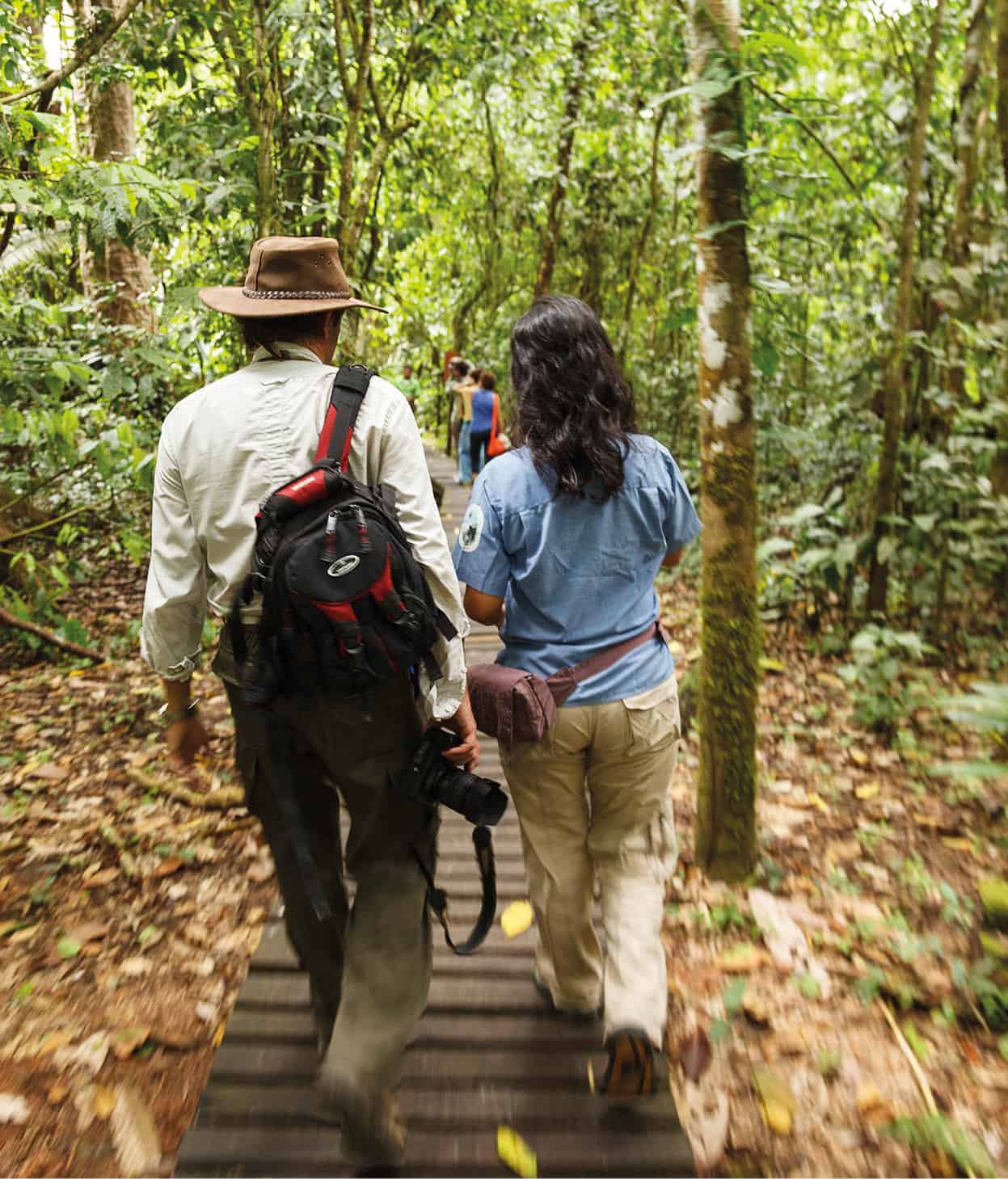
Hiking in the jungle at the Amacayacu National Park.
SuperStock
Since the recent boom in tourism, Leticia 1 [map] has seen more and more visitors from all over the world. Where there once were sleepy working-class neighborhoods, a few malls, and a couple of hotels and hospedajes, broken up by patches of dirt and tall grass, now you’ll see a burgeoning metropolis pushing up against Brazil’s own ever-expanding municipality, Tabatinga. Those who arrive by plane will see a scale model of the grand international hub that is due to replace the current humble airport sometime in the next few years, which spells further growth on the horizon.
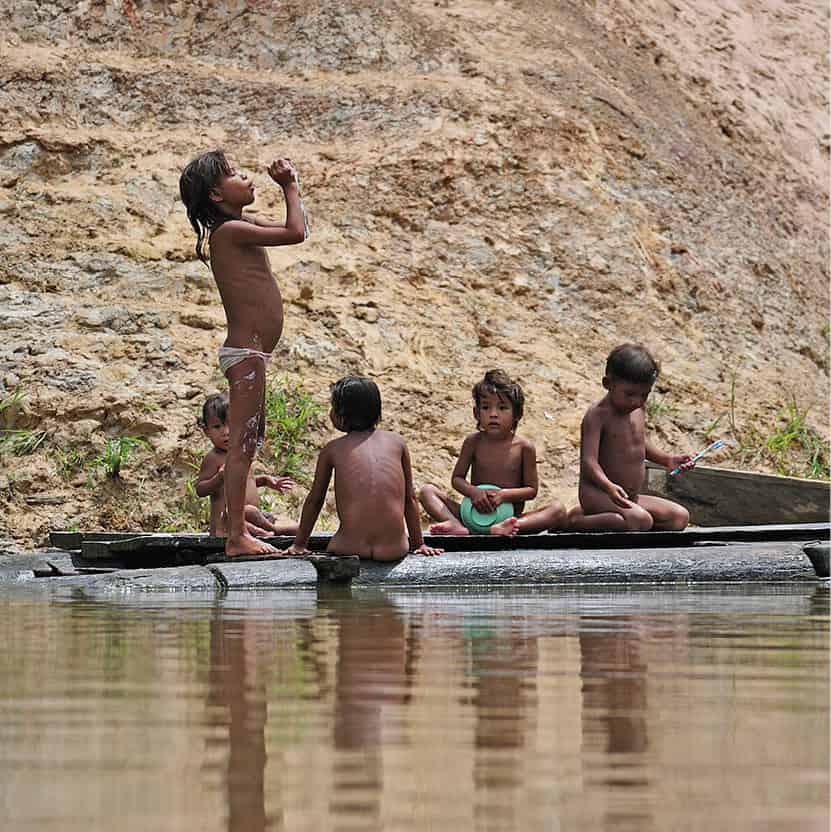
Ticuna children, Puerto Nariño.
SuperStock
Amazonas’ history is an interesting one. Way before there were towns dreaming of expansion, there was the rubber boom. This took place in the late 19th and early 20th centuries when Leticia was still part of Peru’s Loreto Department. This period is regarded as the most ignoble era of the region’s history. The governments of Brazil and Peru sanctioned the enslavement of thousands of local indigenous peoples to toil among the rubber trees, and many died as a result of backbreaking labor and extreme conditions. The Colombian author José Eustasio Rivera recounts the awful conditions in the Amazon Basin during this time in his novel La Vorágine (The Vortex, 1924).
In 1922 Peru ceded Leticia to Colombia in exchange for rights to the land south of the Putumayo River. In 1932, however, Peru had a change of heart and sent 200 soldiers to occupy the town. The conflict became known as the Colombia-Peru War and was settled the following year by the League of Nations, who awarded the territory to Colombia. Tensions have been mostly stable from then until the present day, although not without Colombia maintaining a conspicuous military presence in town. In accordance with Colombia’s constitution of 1991, some 52 percent of the Colombian Amazon has been set aside for indigenous peoples in the form of 121 resguardos (reserves) home to some 55,000.
Amazonian vision?
The North American indigenous have their peyote, the Bwiti people of Africa have their ibogaine, and the natives of the Amazon have ayahuasca. A medicinal herbal brew, ayahuasca roughly translates to vine of the spirit, and is made by boiling the vine and leaf of the banisteriopsis caapi vine. Also known as yagé, ayahuasca is the central component in many indigenous spiritual ceremonies in the Amazon. Drinking the potent mixture leads to altered states of consciousness, hallucinations, and can last between 4–8 hours. Therefore, these ceremonies should always be conducted under the watchful eye of an experienced guide, usually a spiritual shaman. Although not recommended, travelers can pay to take part in these ceremonies.
Planning your Amazon adventure
Major advances in the region’s tourism infrastructure means it’s easier than ever to find cheap flights to and from Leticia. You can purchase tickets in Bogotá, or online in advance, through VivaColombia (for more information, click here), Colombia’s only budget carrier. You’ll want to make Leticia your base and organize all excursions from there.
Leticia’s climate will dictate the clothing and supplies you pack. Average high temperatures hover in the 87°F (31°F) range, with humidity typically in the 60–90 percent range. Durable but light clothing is a must, but trekking boots are mostly useless if you’re planning a hike through the jungle. Most tour operators will provide you with rubber hiking boots, which can stand up to the moisture. It’s also worth noting that there isn’t a rainy or dry season in Amazonas, but rather a high-water season and a low-water season, which denotes the water levels on the Amazon River. The high season is from December to May and the low season is from June to November. The recommended time to visit the area is during the low season, as high water levels make certain excursions difficult.
While the planning can be taken care of on a whim, taking the appropriate precautions might just mean the difference between the Amazonian experience of a lifetime and a few days sick in bed. There are countless animals in these jungles and many of them can make travelers quite sick. Insect repellent is a must, as Amazonian bugs love to feed on unsuspecting travelers.
The CDC lists environments in Colombia at altitudes below 1700 meters (5,577ft) as having a low but potential risk for malaria. This applies to Amazonas, where mosquito bites are frequent. Talk to any local and you’ll be hard-pressed to find specific incidents of infection, and ex-Bogotá residents who have lived there for decades without taking medication have never had the disease. Still, travelers who want to err on the side of caution can invest in malaria tablets such as malarone, or a round of doxycycline. Consult your doctor before traveling.
Tip
Although malaria is rare in Colombia, mosquitos are abundant in Amazonas. Check with your doctor before leaving for Colombia to see if a course of anti-malaria treatment is right for you.
The CDC also recommends that all visitors to Colombia (no matter the region) to get a yellow fever vaccination. As of early 2017 immigration wasn’t specifically checking for yellow fever certificates or mandating shots, but this could change in the future – especially when Leticia’s small airport finally gets its international upgrade. Travelers in Bogotá without their shots can go to the long-distance bus terminal, where a small medical clinic will administer shots for anyone, including foreigners, for free.
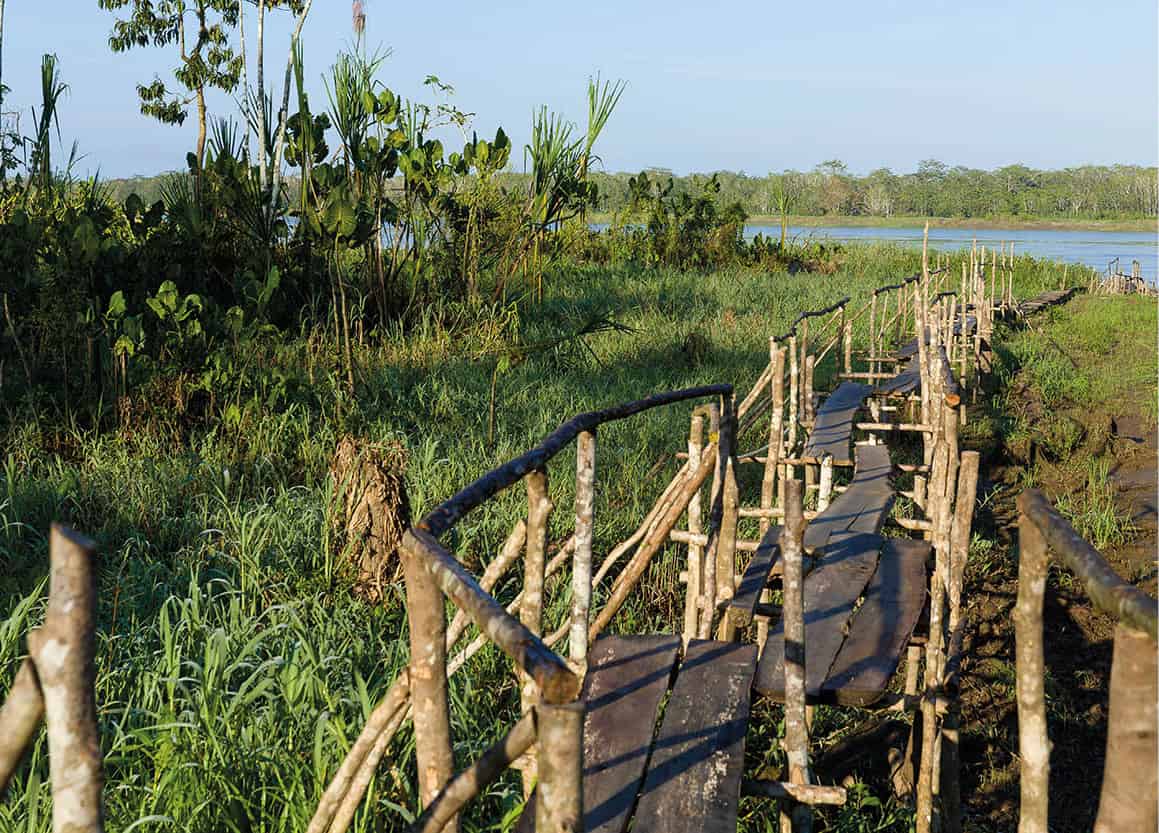
Bridge between a lodge and the Amazon River.
Getty Images
Arriving in Leticia
Anyone arriving in Leticia is subject to an entrance tax. As of January 2017, the fee is US$7. There’s a tourist information point (daily 7am–noon, 2–5pm) in the airport baggage claim next to the entrance-tax payment kiosk. Despite being besieged by new arrivals, they’ll answer questions and provide maps.
In town you’ll encounter tour providers hustling for an honest living, but their persistence can be taxing. Many of these operators run acceptable tours that are comparable from one to the next. However, it is still best to arrange a tour through the reputable companies listed in this book, or through your hostel or hotel. The commercial center, located on Calle 8 and between Carreras 11 and 6, is bustling, noisy, and lined with little other than souvenir shops, mini-markets, and discount retail outlets. However, this is the area to come if you are looking for faster-speed internet cafés, as the Wi-Fi in many hostels and hotels isn’t exactly lightning fast.
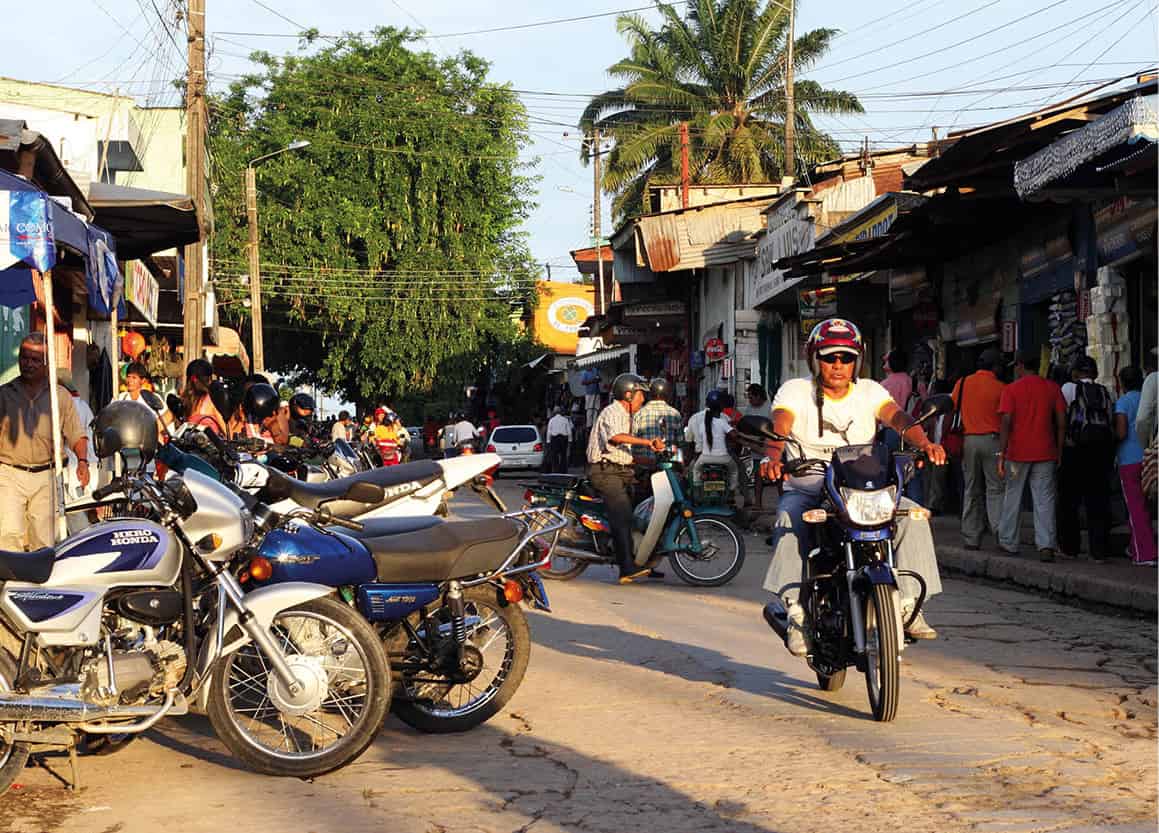
Busy street near the river port in Leticia.
Getty Images
Around town
At the start of Leticia’s downtown, at Calle 8 and Carrera 11, you’ll find Parque Orellana. This may not be the town’s main park, but it is still a good one. There’s a large amphitheater in the center, which often hosts outdoor concerts on weekends, or holiday shows during the Christmas season. At the edge of the park, at the corner of Calle 8 and Carrera 11, you’ll find some good street food in the form of pinchos (grilled, skewered meats), and cold drinks and beer are on hand from the myriad food carts.
If you head a block west from the park on Calle 8 you’ll reach the muelle (dock), the disembarking and departure point for all boats coming to and from town. Its adjacent waterfront walkway is about 100 meters long and is known as the Malecón Turistico, a type of promenade. Anyone booking an excursion to anywhere else on the Amazon will leave from this area.
Just above the docks you’ll find the mercado municipal (Local Market; Mon–Sat 4am–7pm, Sun 4am–2pm), which is another in Latin America’s great tradition of indoor and open-air municipal markets. The best of these are often a maze of produce and meat vendors assaulting your senses with fresh beef, fish, and produce. This mercado municipal is one such place, although its dingy concrete facade reflects the disrepair of the immediate surrounding area. On the ground level workers hack coconut and yucca while produce vendors hock a welcome variety of fruits and vegetables, like papaya, limes, grapes and mangoes. Upstairs, the entire floor is lined with humble, makeshift kitchens acting as mini-restaurants were folks can grab a cheap set-menu breakfast or lunch, often featuring just three options: meat, chicken, or fish. A caldo (soup) usually accompanies the meal.
Two blocks north on Carrera 11 is Parque Santander, the town’s main plaza. On the way you’ll encounter one of the stars of Leticia’s flora, the pomarrosa tree. It produces a sweet fruit similar to an apple, and its lurid flowers shed their needles, coating the nearby ground in an impressive display of electric pink. In the park there is a central fountain as well as a small lake with an arching bridge. It’s a good area to spot birds in the green carbonero trees, and there are plenty of birds to see here.
One of the most pleasant things to do in Leticia occurs every night at sundown when it’s possible to climb up to the top of the bell tower in La Catedral, the cathedral on the east side of the park (US$1 to climb up). Here you’ll witness the return of hundreds, if not thousands, of macaws to their homes in the park’s trees, announcing in a dense cacophony their intention to get a good night’s rest. It’s the perfect environment to survey the country’s southernmost city and take in the Amazonian frontier.
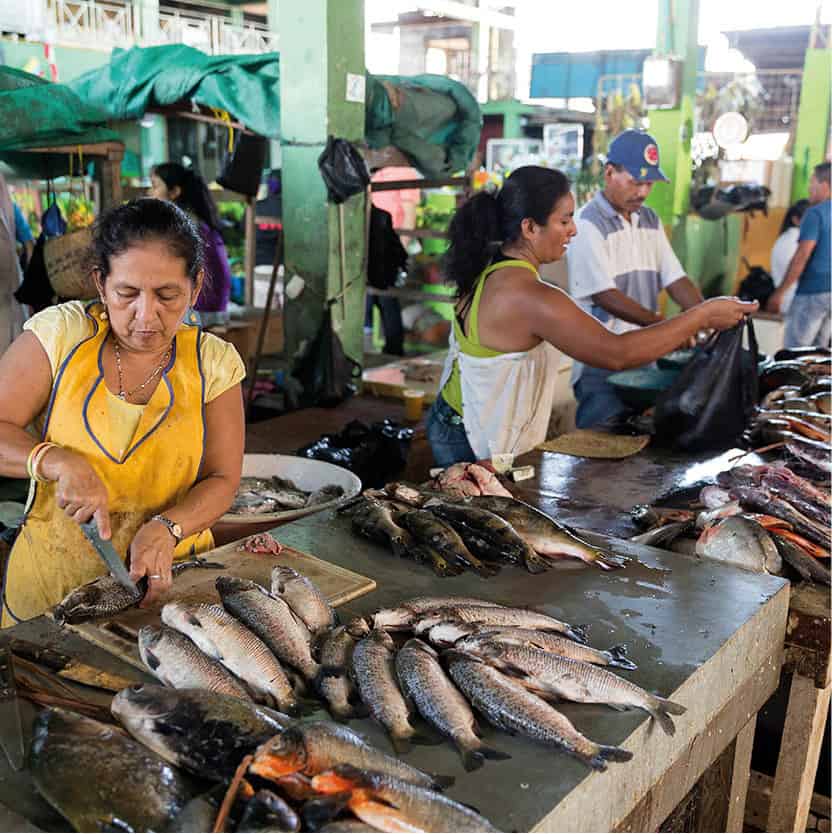
The market in Leticia.
Getty Images
Isla de los Micos
The idea of a mysterious Amazonian island ruled by a cabal of primates seems like the stuff of adventure fiction, but 35km (22 miles) northwest of Leticia, such a place exists. In reality, there is little that’s mysterious about Isla de Los Micos 2 [map], a small island overrun by the mico fraile (squirrel monkey). The island is more a tourist attraction than a protected area, with visitors following professional guides around marked pathways and feeding banana pieces (the only food allowed) to the ravenous inhabitants.
There’s no need to fear the primates either. The micos aren’t ill-tempered Kong-like apes, but rather diminutive bundles of energy with a playful disposition and soft grey fur tinged with yellow. In fact, they are in such abundance on the island, that accidentally treading on them as you walk becomes a real risk. They’re not afraid of human contact either, which makes for great photo-ops, of course, but be sure to keep your pockets zipped up and any small valuables out of reach of the thieving critters.
Many tour operators bundle a trip to this island in their package price, but you can go on your own via water taxi (US$5 each way) and pay the US$10 entry fee yourself. A trip to the Isla de Los Micos is great for families and kids. It’s best complimented by a visit to the Fundación Maikuchiga, a primate sanctuary in nearby Mocagua that offers educational tours regarding the various primate species in the area, as well as information about conservation.
Tip
Be sure to take care of all visa issues and exit requirements from Leticia, before you leave on any river trips. Failure to have the appropriate Colombian exit stamp upon arrival in Peru or Brazil means you will be sent back.
Mocagua
Mocagua is home to 800 members of the eponymous tribe that live in this area of the Amazon. It is about an hour and a half west of Leticia (US$8 by boat) and half an hour east of Puerto Nariño. This is one of many resguardos in the area set aside for indigenous groups, and the Mocaguas have created a thriving, modern community in an ideal location. The town is set on a section of high banks on the Amazon, which allows for breathtaking views of the river. Mocagua even has a ‘disco’, which is really just a terrace bar sitting on a hill that makes a great spot for a sunset drink as the last light of the day disappears over the jungle. There are a couple of hospedajes in town, which can be reserved through operators in Leticia and Puerto Nariño.

Banana vendor and boats at the fishing port, Leticia.
Getty Images
Fundación Maikuchiga
Aside from experiencing the local pace of life in Mocagua, another great reason to come to this area is to visit the Fundación Maikuchiga (www.monkeystory.org). This sanctuary focuses on community conservation, primate research, and the occasional animal rescue. Those who do come will enjoy a 30-minute tour that showcases the various primates in the area. There are five principal species that live in the immediate area surrounding Maikuchiga, including the mono auyador (howler monkey), mico (squirrel monkey), capuchin (the aggressive thief of the jungle), and tamarin. The tour also includes a visit to the home of the fifth and most incredible of all, the leoncito, or pygmy marmoset – the smallest monkey in the world. A full-grown adult will fit in the palm of a human hand, and a child or adolescent can wrap itself around a person’s finger. Here at Maikuchiga there are no captive pygmy marmosets, but the tour does include a visit to their home – a jungle tree. These species live in family manadas (troops) and typically inhabit a single tree. They’re lemur-like in appearance and move at incredible speeds, zipping around vines and branches in order to avoid birds of prey. If you visit the marmoset tree house you’ll notice small circular holes where these omnivorous rascals gnaw into the bark looking for tree gum. Aside from a benevolent giant offering them banana pieces, this is a primary source of nutrition for these tiny creatures.
Monkeys aren’t the only stars of the show at Maikuchiga. The avian inhabitants of the jungle make for a fine sight as well. Colombia in general is a birders dream, as it is home to almost 2,000 different species of birds. Some of the most exotic species reside here in Amazonas, and in the area around Maikuchiga it is possible to see some rare and even endangered species, like the wattled curassow.
For all the wildlife attractions that abound in Maikuchiga, the principal role of the organization is one of conservation, and that is the dominant message. Sara Bennett, a US expat and director of the operation, has been working in the region since 1984. In that time she’s witnessed changes in climate and tourism that threaten the fragile ecosystem of Amazonas. It’s through a simple visit that the average traveler or tourist can learn how they can do their part to preserve these surroundings for generations to come (for more information, click here).
Puerto Nariño
Puerto Nariño 3 [map] is fast becoming one of the most idyllic outposts on the Amazon River, which has its positives and negatives. The community itself is an ideal to aspire to: some 1,200 people (many of them members of the 22 indigenous communities that live in the surrounding areas) have created the smallest official settlement in Colombian Amazonia, and it runs like a dream. Everything here seems to operate in perfect harmony, with community and commerce doing their best to avoid exploiting the pristine environment surrounding the town. However, ever-increasing tourism puts pressure on a fragile ecosystem, and there are already reports of dubious practices like fishing out of season to provide food for Amazonas restaurants.
Still, this town wears its ecological status on its sleeve. There are no cars in Puerto Nariño, and the only vehicle is a tractor used for garbage collection. You’ll see locals trimming hedges daily and beating back the tall grass that threatens to overtake the populated areas, the jungle forcing them to work overtime to protect their little piece of paradise. How Puerto Nariño evolves in the future will be interesting to see, considering it is a young settlement (founded in 1961), with limitless potential.
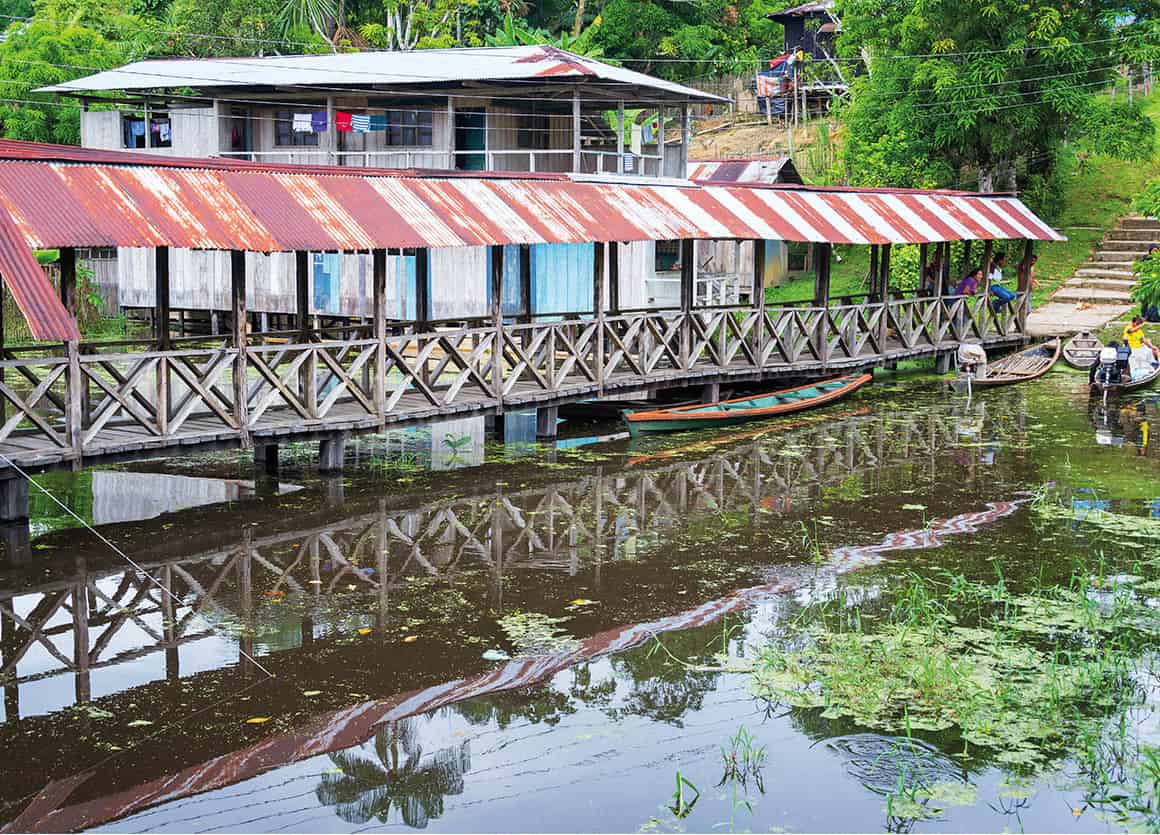
Puerto Nariño.
Shutterstock
Enjoying the town
The only way to arrive at Puerto Nariño is by boat (US$10 each way from Leticia; first boat at 8am and last at 3.30pm). You’ll arrive at the long dock at the town’s entrance, and the first thing you’ll notice is that everything is built on stilts, which is a safeguard for the high-water season. There’s a tourist information point just west of the main dock (8am–noon, 2–5pm) once you get off the boat. Despite its name, this isn’t an ideal place to gather information, as little English is spoken here and they typically don’t possess as much knowledge of the area as the local guides do. Best to reserve your Puerto Nariño excursion through one of these local operators before you leave Leticia.
Separating the town’s front from the river is a well-manicured stretch of lawn dominated by a mini-stadium where locals get together and play basketball or soccer. There’s no real weekend in Puerto Nariño, so locals tend to organize their recreational activities by the time of day rather than specific days. Rising up from the river, the town itself sits on small hills, with residential houses making up most of the structures.
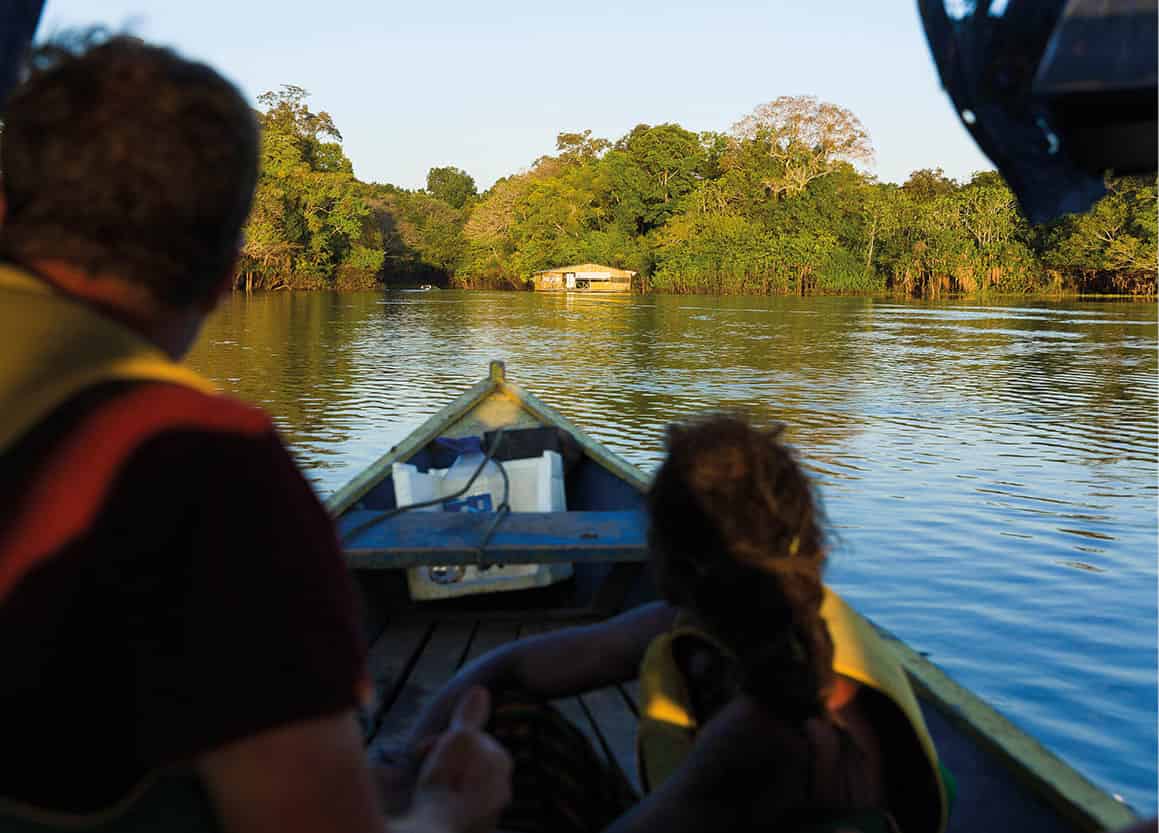
Tourists on the river near Puerto Nariño.
Getty Images
Getting lost isn’t an issue in Puerto Nariño, as the town is only about four square blocks. In the center you’ll find kiosks selling beer, pinchos, and grilled river fish, as well as one of the town’s two restaurants. Fish is the best option, but be sure to ensure that any threatened species, such as pirarucu, is in season before ordering. On the east end of town there is a line of homes that have been converted into small hotels, all with similar accommodations (around US$10/20 for shared/private rooms) and all of good quality. There are mini supermarkets dotted throughout town and two or three small ‘discos’ on the waterfront where locals relax after a day on the river, with a dance and a drink. Those who want to give Colombian traditional dancing a try can arrange a visit through a local operator with Ronaldo, a local who offers dance classes in his house starting at 6pm every day. The styles are eclectic: salsa, cumbia, and the indigenous danza de delfin enamarado (dance of the love-struck dolphin).
Museo Natütama
The small Museo Natütama (Wed–Mon 9am–5pm) in Puerto Nariño, run by the Natütama NGO, is a great introduction to the flora and fauna of the region. The museum offers guided tours (Spanish only), which take about 30 minutes, with an additional 20 minutes of video nature documentaries, which are in English, and includes exhibits of aquatic animals including river dolphins, manatees, turtles and stingrays.
There are various sculptures on display here representing the spiritual connection between river animals and humans, done by local artists from the 7 de Augusto indigenous community.
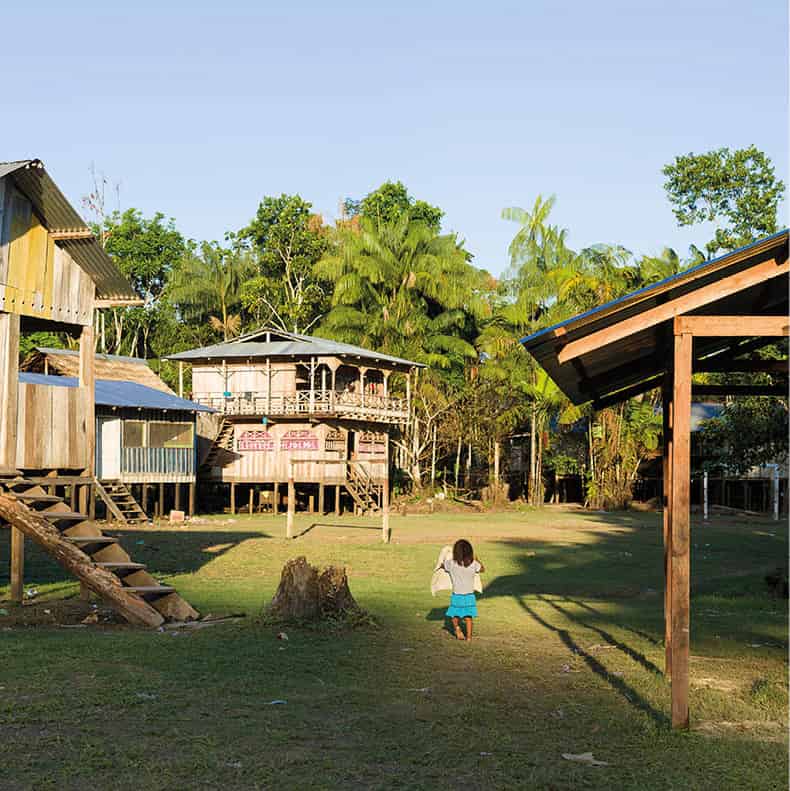
Communal village of Tarapoto Laguna, close to Puerto Nariño.
Getty Images
Excursions from Puerto Nariño
To fully experience the area surrounding Puerto Nariño requires more than a day trip. Reserving a package stay (three or four nights) often involves a number of activities, all of which are remarkable in their own right. Typically these include night walks through the jungle for insect, frog, and spider spotting. Caterpillars, scorpions, tarantulas, and poison dart frogs are all common sights. Other night excursions include caiman ‘hunts,’ which really just involves caiman-spotting on the river from a canoe, although the more fearless guides will try to catch younger caimans by hand in order to show them off to visitors.
Popular day trips include Amazon River swims and pink dolphin-spotting, although manatees and anacondas often prove elusive. Piranha fishing is another activity, as is a visit to local indigenous communities. Those who book their tour through Sergio Rojas’ Amazonas de Turismo will enjoy a visit to his makeshift biosphere on the outskirts of Puerto Nariño. Here, in a manmade lake, caiman, turtles, dragonfish, and the largest scale fish in the world, the pirarucu, seemingly exist in perfect harmony. It’s an amazing place to see various species of animal in one place, and the sight of a 3-meter (10-foot) shadow gliding beneath the water before a huge pirarucu breaches the surface will stay with you for quite some time.
Amacayacu National Park
Near to Puerto Nariño, about 60km (40 miles) northwest of Leticia, is Colombia’s first-ever Amazon protected area: Parque Nacional Natural Amacayacu 4 [map]. Founded in 1975, it stretches some 100km (60 miles) from north to south and covers a whopping 3,000 sq km (1,158 sq miles). The park boasts various ecosystems, including river flood plains as well as terra firma rainforest. Needless to say, this allows for a rich diversity of wildlife.
The park is home to some 5,000 species of plants, 500 species of birds and 150 species of mammals. The greatest diversity of primates in the world is found here, with 12 different species represented; of course in the river you’ll find pink river dolphins and manatees as well. Unfortunately, as of early 2017, the park is closed to visitors and there are no immediate plans to reopen it. However, visitors can visit the edge of the park and see and appreciate its diverse flora and fauna by making excursions from Puerto Nariño or staying in Macagua.
Fact
The rich biodiversity of the Amazon Rainforest is well-documented, but did you know that experts estimate that there around 30 million species of insects in this region? Scientists have even found 700 species of beetle on a single tree.
The indigenous communities
There are three main indigenous groups in Puerto Nariño: the Tikuna, Cocama, and Yagua. These three are collectively known as Aticoya. Many of these groups live in various resguardos stretching from Leticia to Peru. Many of these people have adapted to modern ways of life, but some cultures, like the Tikuna and Yagua have carried their ancient traditions through to modern times. Often this includes wearing traditional dress, living in thatched huts, and even hunting with poison-tipped blow darts.
Spending time in a local indigenous community is a popular excursion from Leticia and Puerto Nariño. This typically involves lunch and dinner (often ajiaco and river fish), and a stay overnight. It’s worth noting that while these trips are enlightening, the indigenous aren’t always enamoured with being treated as tourist attractions, and many just tolerate their guests without actively engaging. Having said that, their culture goes to the heart of the Amazon, and even today they set the tone for sustainable hunting and fishing practices in the area. For example, they don’t hunt certain water animals like river dolphin, and most tribes adhere to a seasonal fishing plan so as not to diminish certain species.
Transportation
All aquatic transportation leaves from the muelle (dock) at the river just below the Mercado Municipal. To journey into Brazil, you must first get your entrance stamp at the polícia federal (federal police station) in Tabatinga. To enter Peru you must get your entry stamp at the immigration office on Santa Rosa Island, a Peruvian community just offshore from Leticia.
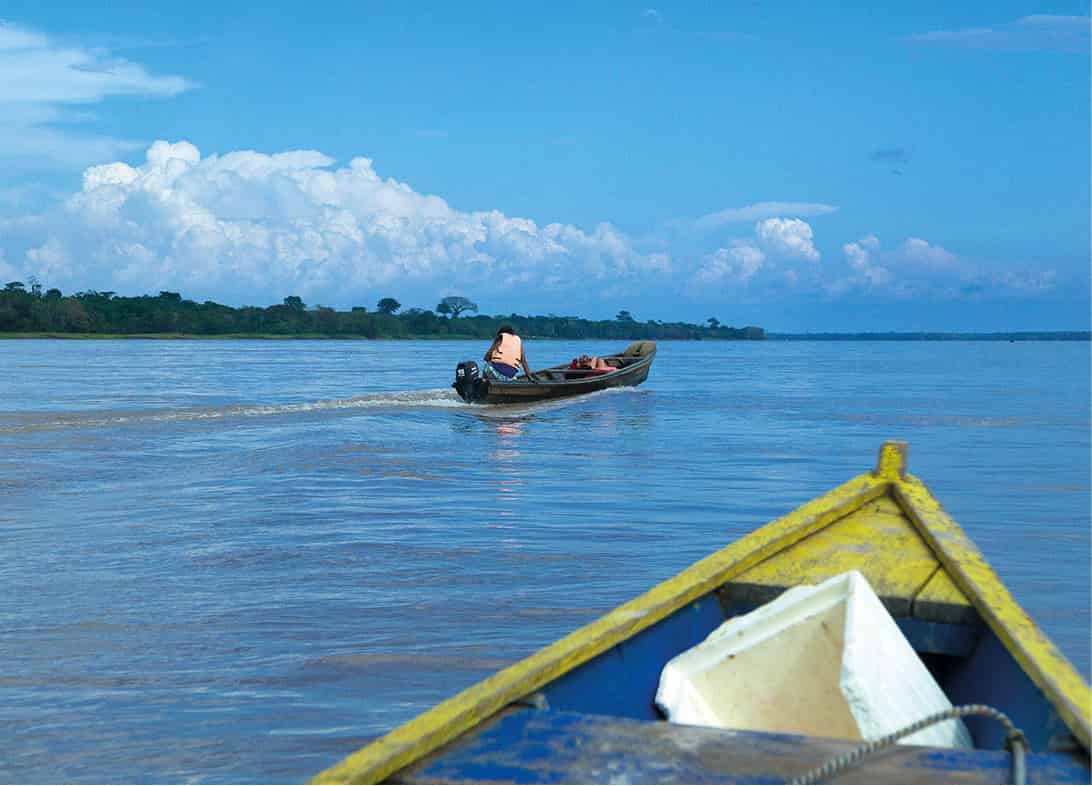
On the Amazon River.
Getty Images
Travel to Brazil and Peru
There’s no immigration control between Leticia and Tabatinga, which is the Brazilian town that borders Leticia to the east. As a result, visitors can travel freely between the two municipalities. However, those who wish to venture deeper into Brazil or Peru will first need to get an exit stamp in Leticia. This can be done at the immigration office in the airport (daily 8am–5pm). You then have 24 hours to exit the country.
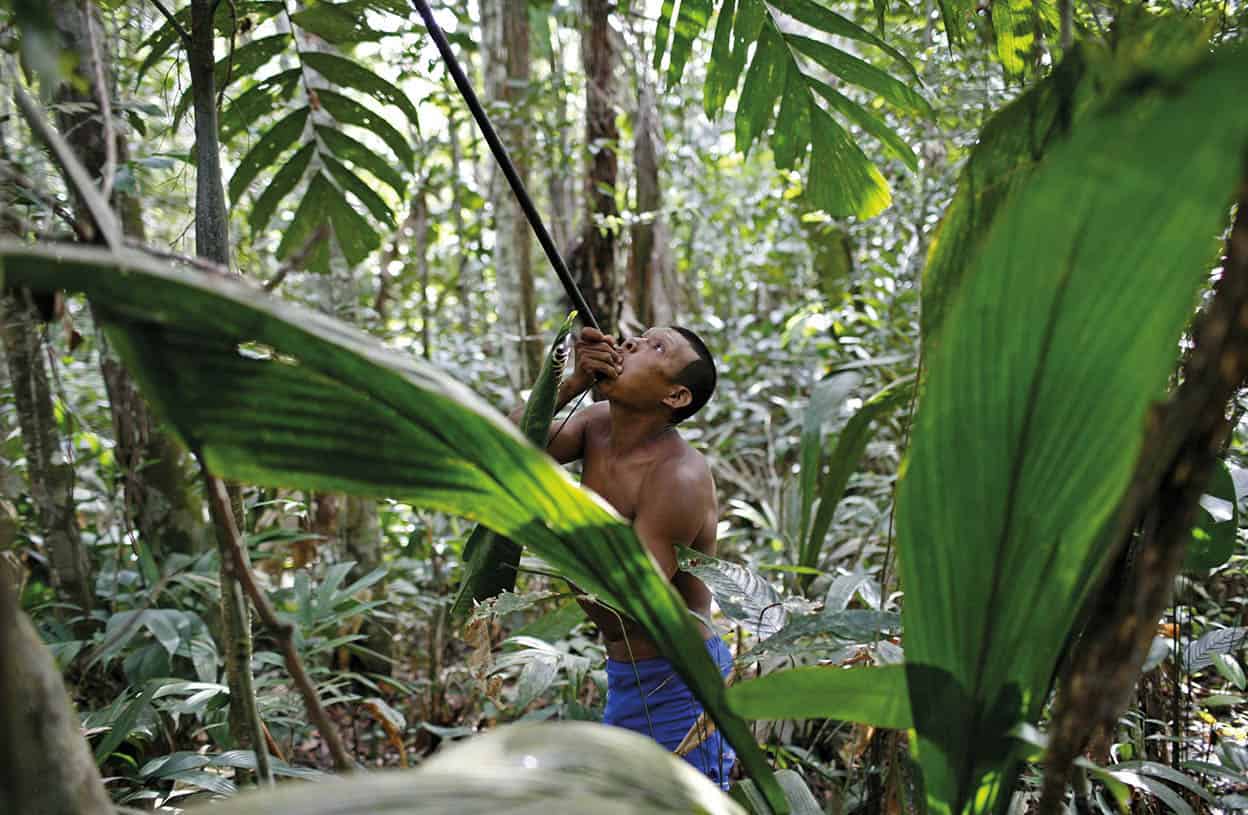
Nukak man hunting for monkeys near Letica.
Sipa Press/REX/Shutterstock
Conservation in Amazonas
Ensuring that Amazonas remains a viable tourist destination for years to come simply means enjoying this destination responsibly.
Colombia’s tourism boom has had undeniable benefits for the country. Unfortunately it also has the potential to threaten certain of Colombia’s more fragile ecosystems. This is especially true in Amazonas Department. As a city, Leticia is growing at geometric rates, and the increases both in size and human footprint since the mid-2000s has been striking. The potential of unfettered tourism to threaten local indigenous communities and smaller settlements, like Puerto Nariño, is very real. Climate change is also a problem, as the water levels of the Amazon River become ever more extreme and unpredictable. This threatens various fish species that are used to finding their food supply in regular locations throughout the year.
Puerto Nariño and the rise of tourism
NGOs first arrived in Puerto Nariño around 2008 and informed the locals of the coming tourism deluge. In preparation, certain residents began training for jobs in tourism, and the best guides and tour operators (those listed in this book, like Amazonas de Turismo), got their start during this period. They are experts in local customs and heritage and also run the most efficient and comprehensive tours without placing an undue burden on the local infrastructure. In short, reserving through local experts means you’ll have a more personalized, fulfilling, relaxing, and enjoyable experience, especially since it’s typically done in smaller groups.
Eating responsibly
Dining in the regions is also something that can either be done correctly or incorrectly. Even the indigenous groups don’t eat certain river animals, including and especially dolphin. However, overfishing for scale fish is an issue and there are certain seasons in which to collect certain monsters of the deep, like the pirarucu. Also, due to its prominence on nature shows, it’s also become somewhat fashionable to eat the mojojoy, a fat white worm endemic to the region. Some restaurants will even sell the animal. However, to find it requires upending entire palm trees, which can threaten the growth of that tree. Generally, it’s best to avoid it altogether.
A word from Maikuchiga
Sara Bennett, of the Fundación Maikuchiga, has been working in Amazonas since 1984 and has some easy-to-follow guidelines for visitors who want to reduce their carbon footprint in the area and behave like responsible eco-tourists. First, make sure you arrange all tours locally, with local operators. Second, make sure the local community is personally involved, especially if it’s an indigenous community. Third, always reserve your excursions in small groups, generally of fewer than 10 people. Adhere to these simple rules and it’s all but assured you’ll enjoy the experience of a lifetime.
